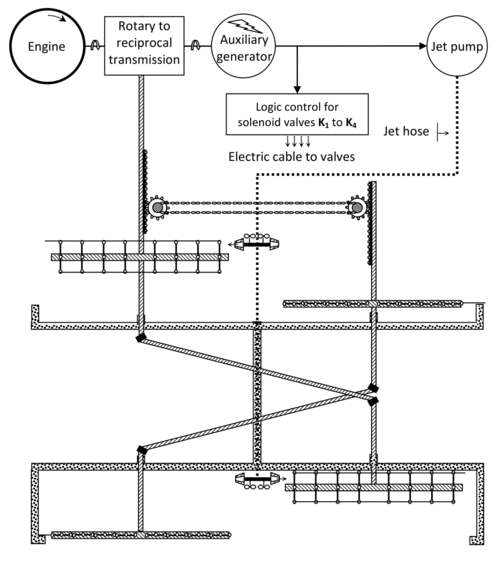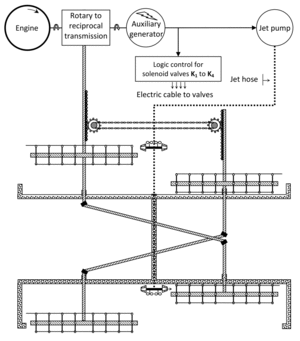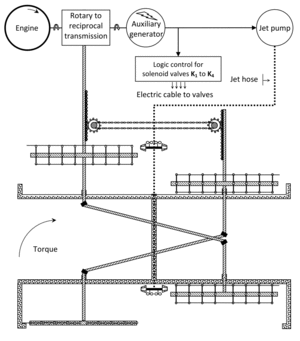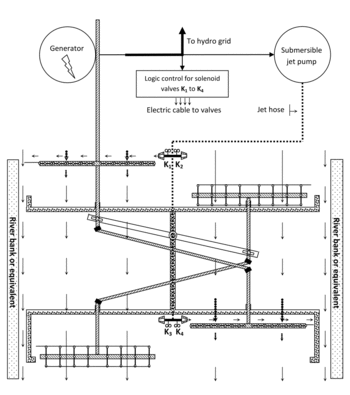Pitch
Get rid of rotary propeller cavitation damage & low efficiency by powerful reciprocal shutter planar propeller at 95% above efficiency.
Description
Summary
Abstract
Why we have to be addictive to screw propellers for marine vehicles? Perhaps we are not smart enough to find a new way. Now I propose innovative flapping-shutter propellers that work in reciprocal mode to drive ships. In a sense, it is biotic invention to mimic ducks that swim by big feet propulsion. By analogue, fluid flows in similar way of electric DC (Direct Current), but reciprocal motion of propellers behaves in similar way of AC (Alternating Current), thus it is essentially an AC-DC fluid rectifier.
Introduction
Watching how a duck swim on water in figure 1.
Her 2 feet just run in alternative reciprocal mode, when her feet surface is vertical to water level, the respective leg is always on the way of backward pushing water, hence propulsion is in action; else when her feet is in horizontal position, the respective leg is always on the way of forward retraction, hence preparation for next propulsion can be done with small resistance.
Following picture shows the moment that a swimming duck’s right foot is in propulsion stroke whiles left foot in retraction stroke.
This scenario inspires a bionic propulsion mode.
As the propulsion direction is always in same line of object’s desired or supposed motion, of course, such propulsion mode can maximize the propulsion efficient.
Compared with regular screw propellers, the vane’s surfaces are never vertical to motive direction, and the pushed water not only acquires translational kinetic energy, but also spinning energy, no wonder big energetic wave in wakefield!

Fig. 1: duck in action
Even a swimmer can swiftly use extended artificial "feet" as better propeller, as illustrated in figure 2:

Fig. 2: swimmer
For huge load, such as sea container ship, propeller designers care more about the driving force than speed.

Fig. 3: container ship
Its huge rotary propellers always suffer from cavitation problem.

Fig .4: cavitation inevitable in rotary propeller, expensive repair.

Fig. 5: affected water's energy gained = kinetic + angular
Is this proposal for a practice or a project?
Practice
What actions do you propose?
Hydrodynamics design
According to Bernoulli equation, the areal power density can be deduced = 0.5*density*cubic-of-velocity, water density is 1000 kg/m^3.
Hence, the faster the board propeller, the cubically powerful the power unit should be.
Given engine power, and max knots, the required propulsion area can be calculated.
For example, a cruise ship with 20 MW engine, and 30 knots velocity, i.e. v = 30*0.514444 = 15.43 m/s, thus the max areal power density = 0.5*1000*15.43^3 = 1,836,825 watts per square meter = 1.8 MW/m^2.
Therefore, the required propeller’s board area = 20/1.8 = 11.1 m^2.
The punching velocity should be larger than the max rated travel speed; otherwise, it has no propulsive function at high speed state, but dampens the inertia.
Generally speaking, there is a formula:
Valid-propelling-force = total-force * cos(the-angle),
where the-angle is the angle between driving force and vehicle moving direction.
For rotary propeller the-angle is not zero, but zero for shutter propeller, that is why the subject invention has higher efficiency than conventional one.
Implementation
The simplest is showed bellow:
Fig. 6: single shutter propeller
It works in simplex mode, just like a single diode used in the simplest rectifier.
Following figure shows a propelling system in duplex mode:

Fig. 7: duplex system comprising 4 shutters
In fact, it is a mechanical mimic to four diodes rectifier in this figure:

Fig. 8: similarity between this invention & bridge-rectifier
The jet pump for small ship can be good enough, but for large to huge ship, it may need be replaced by hydraulic actuator for easy open/close toggle of shutters.
By replacing the swinging bar with gears, we can further improve its efficiency. Below figure shows the replacement:

Fig. 9: further improvement
For better understanding of its working principle, watch this animation:

Fig. 10: the duplex 4-shutter propellers system animation
A ship equipped with such propeller system will look like this from the back:

Fig. 11: back view of a ship with 4-shutter propellers
Aerocraft application
The density of water is 813+ times heavier than air, therefore, for same driving force, the shutter in air must move more quicker than in water: cubic root of 813 = 9.3 folds.
In marine application, e.g. container ship 24 knots, the shutter speed about 12.3 m/s, therefore, for same load cargo aerocraft , the shutter speed should be 115 m/s. Of course, for light duty aircraft, speed requirement can be reduced greatly, e.g. 50 m/s for passenger ornithoper.
The piston speed of most internal combustion engine is about 20 m/s, thus, the regular powertrain with speed reducer gear is not competent to drive aircraft shutter propeller.
Instead, I invented pulse power system to drive aircraft shutter propellers, so as to reach 50 to 350 m/s (> sound speed) shutter speed.
For marine use, needless to use pulse power, and shutter usually is made of steel plates, luckily for aircraft, even fiber cloth can be used in its umbrella propellers, as illustrated below:

Fig. 12: umbrella propeller for vertical take-off airplane
Although shutter propeller still can be used in aircraft, however it needs an air pump to toggle the shutter for open or close, if use umbrella to replace shutter, then no need of an air compressor.
Who will take these actions?
Where will these actions be taken?
In addition, specify the country or countries where these actions will be taken.
No country selected
Country 2
No country selected
Country 3
No country selected
Country 4
No country selected
Country 5
No country selected
Impact/Benefits
What impact will these actions have on greenhouse gas emissions and/or adapting to climate change?
The great increase of efficiency will benefit the globe climate, so as to decrease the greenhouse gas emissions.
Although efficiency can be judged on this equation:
Force_valid = Force_native * cos (theta), here theta is the angle between propeller surface normal line and heading direction,
and obviously for the shutter propeller, the theta = 0, but for screw propeller is acute angle, thus the former top efficient, but the latter less efficient,
however, that is not all story of screw propeller, because the acquired angular rotation energy of stirred water can not be ignored.
It is the angular energy that makes great wave after ship pass away, and the powerful wave can even propagate a few of kilometers far away, then results in riverbank erosion!
All old theoretical analysis on efficiency of screw propeller neglect the water acquired angular energy, those fluid-mechanic models just simply treat the stirred water as rigid body without rotation. Therefore, the orthodox estimation should be further reduced.
In average, the efficiency of rotary blade propeller is circa 50% in normal navigation, as illustrated below:

Fig. 13: theoretical efficiency curves without consideration of water absorbed angular energy
Half more of total energy is dissipated to water kinetic & angular energy.
Obviously, shutter system not only gets rid of cavitation problem, but also maximizes propulsion efficiency, especially almost no dragging resistance while idling, so as to benefit from inertia and free tailwind if possible.
The shutter propeller will increase the efficiency up to 95%, that is marvelous improvement!
One large ship may use 380 tons/day fuel. My invention could reduce that to 70 tons/day at max. There are 90K large ships running on whatever water body at any given time, just image how much fuel saving & emission reduction!
Even only 10% efficiency increase, the fuel saving and CO2 cutoff is tremendous all over the world, especially for the fuel guzzlers aircraft carriers and container shipping fleets.
What are other key benefits?
Other benefit 1:
If this propeller is used in submarine, then it will be almost silent even accelerating under water.
This feature has great military advantage for navy!
Therefore, at least, the department of defense (DoD) in any country will love this invention.
Other benefit 2:
The shutter propellers system can also be used for steering ship without a dedicated rudder or say helm.
Because the 4 solenoids can be controlled independently by computer, therefore if one side shutters are always open, and another side shutters can be toggled open or close, then the propeller system will generate a torque, then steer ship to left or right.
Bellow animation illustrates a method of left turn,

Fig. 14: left turn
Bellow animation illustrates a method of right turn.

Fig. 15: right turn
The above 2 animations are just simplex steering methods, for doubling steering effect, computer can also select duplex steering method.
Recently, the U.S. warships in the Asian-Pacific region have been seen many times hit-accidents with civil ships, & some soldiers died, perhaps, it means that marine vehicular steering system is still a problem, the traditional rudders or helms are indeed not promptly responsive.
In a sense, my shutter-steering mechanism is an active method, but rudder-steering mechanism is passive, therefore, my invention may be the most responsive steering method.
By the way, even for aircraft application, this steering benefit is also available.
Other benefit 3:
Almost zero resistance on idling shutter propeller system, because all shutters are open in idle mode and only tiny side area is facing motion direction:

Fig. 16: idling shutter propeller system
In general, the thinner the shutter slice-vane, the smaller the side area, then smaller the water resistance, but vane thickness should be at least ensure enough mechanic strength.
In contrast, for regular rotary screw propeller, if the propeller stops rotation, then huge dragging resistance exists, because large propeller area facing motion direction, and no way to fold it for avoidance.
Other benefit 4:
By reversing the pushing direction of closed shutters , the shutter propeller system itself can also temporarily function as an active braker for quick deceleration.
Costs/Challenges
What are the proposal’s projected costs?
$1M = phase I - laboratory prototype $200K + phase II - finalization via an experimental ship $800K.
High Net Worth Individual (HNWI), any entity, even Sovereign Wealth Fund (SWF) in the world are welcome to funding this project.
The SWF can seek with high priority to monopolize fruits & rights exclusively if there is one investment & this special interest is requested, as long as agreement of buyout all personal or any other entity's rights can reach via negotiation.
Timeline
About the author(s)
Related Proposals
1. Commercial flapping-shutter ornithopter era will come soon
2. Shutter-like turbine for low head shallow river/canal/sewer hydropower system
By the way, motor and pump can be always convertible. I also use the same mechanism to propose a shutter turbine for harvesting low head water kinetics, check the "related project" box for that application.

Fig. 17: shutter turbine for hydro power generator
References
1. Basic principles of ship propulsion:
2. I just copy my full science paper here, though you can also download from my paper collection archive link: http://vixra.org/author/yanming_wei
